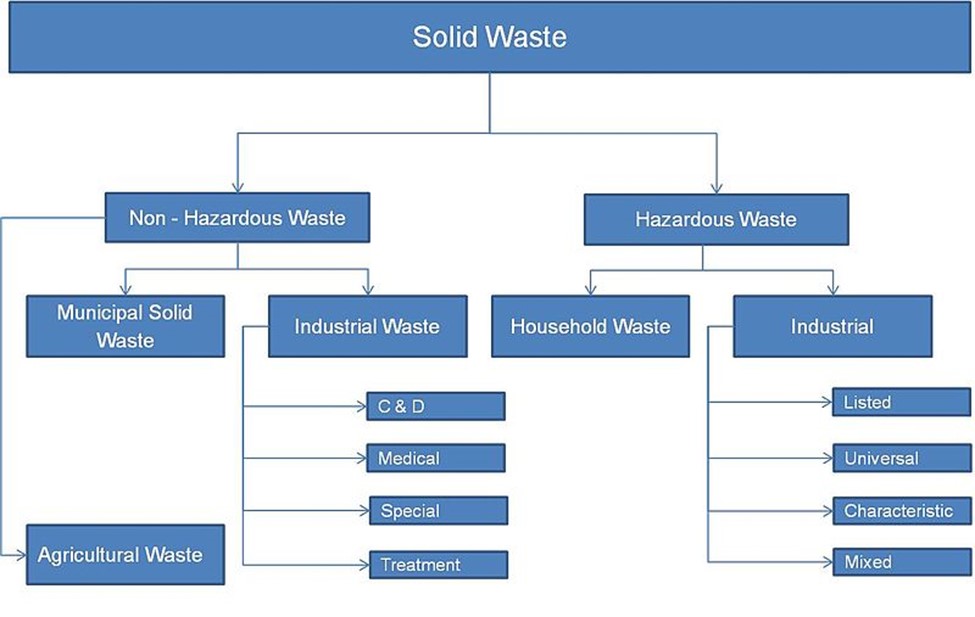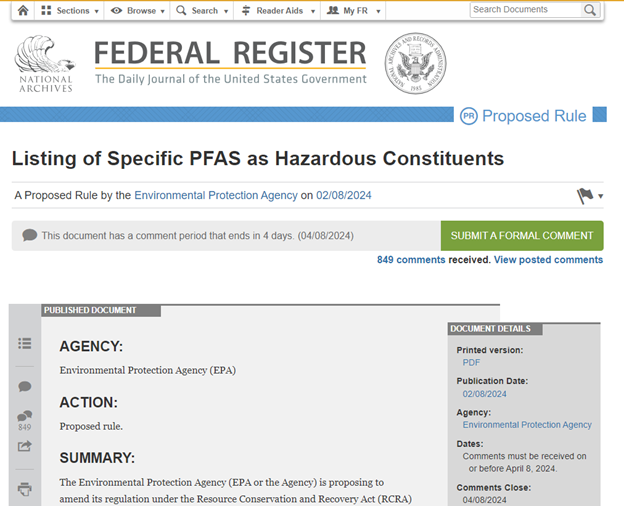
The public comment period for the EPA proposal to list 9 PFAS as hazardous constituents under the Resource Conservation and Recovery Act (RCRA) ends on 8 April 2024. You may submit a comment here. The 9 PFAS are PFOA, PFOS, PFBS, HFPO-DA, PFNA, PFHxS, PFDA, PFHxA, and PFBA. This includes the 6 PFAS which were have a proposed maximum contaminant level under the Safe Drinking Water Act: PFOA, PFOS, PFHxS, HFPO-DA, PFNA, and PFBS. It may be helpful to review the article on PFAS nomenclature. The intent of this article is to encourage informed public participation in the rule making process. To that end, I plan on covering what RCRA is, what a hazardous constituent is, what that means, and what I, acting in my own personal capacity not representing my employer, think. Please remember that my views are my own and I do not work in this area!
RCRA Introduction
RCRA was first signed into law 21 October 1976 and had major amendments in 1984, 1992, and 1996. RCRA itself is an amendment to the first federal solid waste statute (the Solid Waste Disposal Act of 1965) which is typically included in the term. RCRA governs solid and hazardous waste disposal in the United States and is known for its “cradle to grave” management framework. This law has multiple subtitles, the most referenced are Subtitles C, D, and I.

RCRA Subtitle C
Subtitle C establishes the cradle to grave framework for hazardous wastes which means from the point of generation through transportation, treatment, storage and disposal hazardous wastes must be tracked, handled, recorded, and stored in specific ways.
RCRA Subtitle D
Subtitle D covers for non-hazardous solid wastes. Among other things it banned open landfills. This section covers sludge from industrial wastes, wastewater treatment plants, and drinking water plants as well. It also excludes small quantity generators from having to follow Subtitle C requirements.
RCRA Subtitle I
covers underground storage tanks (USTs) containing petroleum or other listed hazardous substances and provides technical, monitoring, and reporting standards for them.
A note on RCRA Special Wastes
Several wastes, known as “special wastes,” are industrial wastes which were exempted from Subtitle C and includes oil and gas exploration wastes (such as drill cuttings, produced water, or drilling fluids), coal combustion residuals (fly ash, bottom ash, slag waste and flue-gas desulfurization wastes), mining waste, and cement kiln waste.
What is a Hazardous Constituent?
A hazardous constituent is not a hazardous waste. Instead, it is anything listed in 40 CFR part 261 Appendix VIII. A hazardous constituent listing is a step toward a potential hazardous waste listing. To list a waste as a RCRA hazardous waste under 40 CFR 261.11(a)(3), the waste must contain a hazardous constituent listed on Appendix VIII and determine that it is capable of posing a substantial hazard. Additionally, when a corrective action is required, hazardous constituents are expressly identified for consideration and RCRA section 3004(u) requires that any permit issued to a treatment, storage, or disposal facility after November 8, 1984 requires corrective action for all hazardous waste or constituent releases from solid waste management units at the facility. There are additional regulations surrounding hazardous constituents in parts 261, 264, 265, 268, and 270 however, these are not particularly relevant here. To be listed as a as hazardous constituents under RCRA, a substance must have been shown in scientific studies to have toxic, carcinogenic, mutagenic, or teratogenic effects on humans or other life forms.
Does this affect drinking water?
I do not believe so because hazardous constituents do not make themselves, or the wastes containing them, RCRA hazardous wastes. Only hazardous waste treatment storage or disposal facilities are subject to RCRA corrective actions according to 42 U.S.C. 3004(u)(v). I supposed it is possible that a drinking water plant is a hazardous waste treatment, storage, or disposal facility but that would be novel for me. There’s also a domestic sewage exclusion in 40 CFR 261.4(a)(1), which excludes domestic sewage and any mixture of domestic sewage and other wastes that passes through a sewer system from being considered solid wastes (with some exceptions). However, remember folks I’m not a lawyer and don’t know law.
Why is it important to submit a comment?
Simply put the EPA generally listens if you have a well thought out point and it is important to participate in the laws which govern you.
How to submit a comment
To submit comments, just click the “submit a formal comment” button as shown in the picture below. You can also view all comments submitted. Once the public comment period closes, the EPA reviews all the comments and replies to every one; I’m glad I wasn’t working on this Clean Water Rule which received over 1,000,000 public comments.

What do I think?
I believe that the EPA has shown that the nine PFAS, their salts, and their structural isomers meet the listing criteria for RCRA hazardous constituents because there is plenty of detailed, peer reviewed, well established scientific studies that show that these PFAS have toxic effects on humans or other life forms. I believe that it would have been better if rather than listing individual chemicals a structural definition was provided.
I understand the argument that there may not be enough evidence to show that a structural definition should apply however, to quote:
George W. Bush, 43rd US President
To be honest, PFAS is starting to resemble Christopher Duntsch, also known as Dr. Death. He is one of the only, if not the only, surgeon to face felony accounts for maiming his patients. This is because every doctor is human and humans make mistakes. The prosecution successfully argued that Duntsch should have known he was likely to hurt others unless he changed his approach, and that his failure to learn from his past mistakes demonstrated that his maimings were intentional. Likewise, with PFAS, I feel that even though we may lack specific studies for all perfluoroalkyl carboxylic acids or perfluoroalkyl sulfonic acids from say C4-C20 but at this point are we learning from similar enough chemicals? Baseball is three strikes and you’re out; this listing includes 5 perfluoroalkyl carboxylic acids, 3 perfluoroalkyl sulfonic acids, and 1 perfluoropolyether carboxylic acids could we not just say perfluoroalkyl carboxylic acids or perfluoroalkyl sulfonic acids at this point? How different does something have to be so we prevent regrettable substitutions?

Conclusions
Even if you don’t agree with me you should participate in your democracy! I plan on submitting a comment agreeing with this, if you don’t agree with it why not submit a comment to balance me out? Don’t worry if you miss this opportunity, there are many opportunities to participate in federal decision-making and occur before a rule is proposed, after a rule is proposed, and even after a rule is finalized as this handy site from Harvard’s Environmental and Energy Law Program shows.